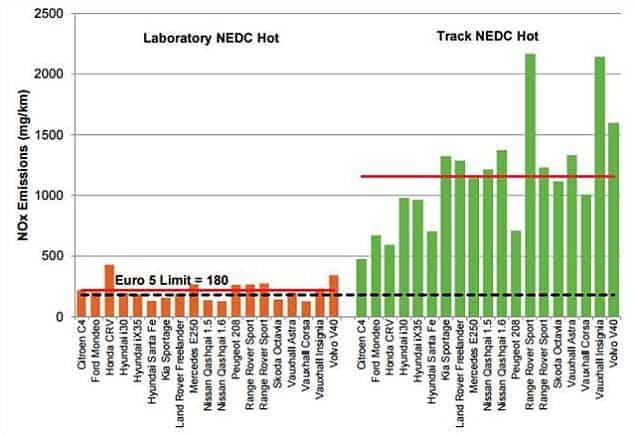According to the most comprehensive set of data, almost no diesel cars respect pollution limits, with a quarter producing over six times more than the limit.
Breaking the rules

About six months ago, in September 2015, the United States Environmental Protection Agency (EPA) issued a notice of violation of the Clean Air Act to the Volkswagen Group. The notice was issued because Volkswagen had intentionally cheated on the emission tests. The announcement was met with public outroar, and a swarm of legal repercussions which are still in process. But soon after that, another question emerged: is Volkswagen a singular bad apple, or is this a more common practice than we thought?
A study conducted by Adac, Europe’s largest motoring organisation, revealed that diesel cars made by Renault, Nissan, Hyundai, Citroen, Fiat, Volvo and many others also emit more than they should – and more than they declare. The figures were staggering. These weren’t minor breaches, with pollution levels exceeding the allowed ones by 10 or 20 percent – in some cases, cars emitted ten times more than the limit. It became clear fast that this is a much bigger problem than previously thought, and this new analysis confirms those fears.
The new data comes from the Emissions Analytics (EA), a UK-based emissions consultancy agency and one of the biggest in the business. They covered 250 vehicles in more stringently standardised road conditions, finding that just one Euro 5 diesel (the EU standard from 2009) did not exceed the limit. Another seven Euro 6 Diesels (the stricter standard from 2014) fell into the accepted limits. In total, a whopping 242 out of 250 cars emitted more than they should have. Over a quarter emitted six or more times the accepted limit.
Legally illegal

Robert Goodwill, a transport minister, said he was “disappointed” by the results and accused manufacturers of “gaming” the testing system. However, in the strictest sense of the law, the producers may have done nothing wrong – it’s the testing system that is flawed.
Several notable universities including the Imperial College London carried out tests in the laboratory, on testing tracks and in real life conditions. They found that the lab tests (which are the current norm for establishing the pollution levels of a car) are nowhere near accurate when it comes to real-life conditions. This is not a case of car producers “fixing” the cars to cheat on the tests, it’s a case of the tests themselves being inaccurate. In other words, lab simulations greatly underestimate the amount of pollution. Ironically, Volkswagen cars fared among the best in the real-life tests.
Naturally, the involved organizations tried to downplay these results, with the Society of Motor Manufacturers and Traders stating that the difference between lab and real world tests were ‘well known’. Sure, this may be the case in the academic world or for the car industry but for the general public (and I’d bet some policy makers as well) these differences are certainly not ‘well known’. The emission limit is set for real-life conditions, so if the differences are indeed known, then the system should be changed to reflect these real conditions.
EA also highlights another trend: some car manufacturers are actively trying to reduce their emissions while others are simply trying to pass tests.
“There is a growing worry about air pollution, but while some car manufacturers have been more proactive, others have done only the minimum,” said Nick Molden, the CEO of EA. “The point is diesels can be clean.”
More emissions, shorter lives

It’s well documented that diesel emissions cause a number of health conditions and lead to overall shorter life expectancies. Urbanized areas like London, New York or Shanghai have experienced a significant reduction in air quality, a reduction that can be at least partially attributed to cars. According to The Guardian, the British government estimates this pollution is responsible for 23,500 premature deaths a year. The government already lost a supreme court challenge in 2015 over the adequacy of its plans to tackle the crisis and is uncertain about its future strategy.
Over the last few months, it has become evident that at least in the Western World, this problem is at a much greater magnitude than previously thought. When Adac published their analysis last year, things seemed pretty dire. At the time, Reinhard Kolke, head of test and technical affairs at Adac’s state-of-the-art test centre in Bavaria, told the Guardian:
“If all cars complied with [the official EU NOx limit], we would have solved all the worst health effects. Every consumer has the right to expect all manufacturers to do this. But still there are these gross emitters.”
Now, as more and more studies are revealed on the matter, it’s looking even worse. We need a unified strategy to ensure that car producers are respecting emission limits but that seems nowhere in sight. As mentioned above, several universities and research groups are working closely with producers, so the data is probably there – we just need to do something useful with it.






